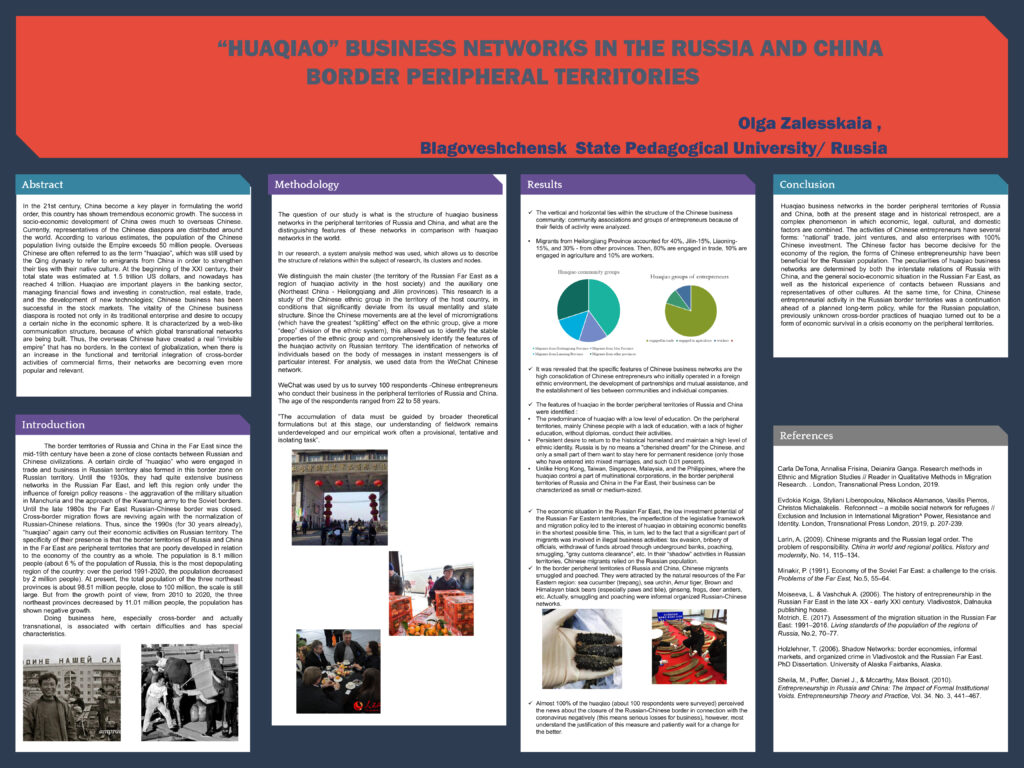Olga Zalesskaia
Time and Place: Thursday, 01.07., 16:00–17:00, Room 2
Session: Poster Session – Networks and Spatial Analysis II
Keywords: “Huaqiao”; business networks; Russia; China; border territories
It is known that success in socio-economic development of China owes much to its foreign compatriots. Currently, representatives of the Chinese diaspora are distributed around the world. According to various estimates, the population of the Chinese population living outside the Celestial Empire exceeds 50 million people. Foreigners from China are often referred to as the term “huaqiao”, which was still used by the Qing dynasty to refer to emigrants from China in order to strengthen their ties with their native culture. Nowadays, their total state has reached 4 trillion US dollars. Ethnic Chinese are important players in the banking sector, managing financial flows and investing in construction, real estate, trade etc. The vitality of the Chinese business diaspora is rooted not only in its traditional enterprise and desire to occupy a certain niche in the economic sphere. It is characterized by a web-like communication structure. Thus, the overseas Chinese have created a real “invisible empire” that has no borders.
The border territories of Russia and China in the Far East since the mid-19th century have been a zone of close contacts between Russian and Chinese civilizations. A certain circle of “huaqiao” who were engaged in trade and business in Russian territory also formed in this border zone on Russian territory. Until the 1930s, they had quite extensive business networks in the Russian Far East, and left this region only under the influence of foreign policy reasons. Until the late 1980s the Far East Russian-Chinese border was closed. Cross-border migration flows are reviving again with the normalization of Russian-Chinese relations. Thus, since the 1990s (for 30 years already), “huaqiao” again carry out their economic activities on Russian territory. The specificity of their presence is that the border territories of Russia and China in the Far East are peripheral territories that are poorly developed in relation to the economy of the country as a whole. Doing business here, especially cross-border and actually transnational, is associated with certain difficulties and has special characteristics.
The question of our study is what is the structure of huaqiao business networks in the border peripheral territories of Russia and China, what are the distinguishing features of these networks in comparison with huaqiao networks in the world, and how effective and stable are these networks in the context of Russian-Chinese relations, modern macroeconomic and global political trends (China’s relations with other countries, trade sanctions, the coronavirus epidemic, etc.).
In the study, a network analysis method was used, which allows us to describe the structure of relations within the subject of research, its clusters and nodes. We distinguish the main cluster (the territory of the Russian Far East as a region of huaqiao activity in the host society) and the auxiliary one (Northeast China – Heilongqiang and Jilin provinces). This study is a study of the Chinese ethnic group in the territory of the host country, in conditions that significantly deviate from its usual mentality and state structure. Since the Chinese movements are at the level of micromigrations (which have the greatest “splitting” effect on the ethnic group, give a more “deep” division of the ethnic system), this allowed us to identify the stable properties of the ethnic group and comprehensively identify the features of the huaqiao activity on Russian territory.
The paper analyzes the vertical and horizontal ties within the structure of the Chinese business community: community associations and groups of entrepreneurs because of their fields of activity. It was revealed that the specific features of Chinese business networks are the high consolidation of Chinese entrepreneurs who initially operated in a foreign ethnic environment, the development of partnerships and mutual assistance, and the establishment of ties between communities and individual companies. It is analyzed how the huaqiao network created in the Far Eastern border area adapts to the legal norms of the host state and prevents the interference of other ethnic groups in their areas of activity. The identification of networks of individuals based on the body of messages in instant messengers is of particular interest.1 For analysis, we used data from the WeChat Chinese network. Thus, almost 100% of the huaqiao (about 50 respondents were surveyed) perceived the news about the closure of the Russian-Chinese border in connection with the coronavirus negatively (this means serious losses for business), however, most understand the justification of this measure and patiently wait for a change for the better.
Huaqiao business networks in the Russian Far East, both at the present stage and in historical retrospect, are a complex phenomenon2 in which economic, legal, cultural, and domestic factors are combined. The activities of Chinese entrepreneurs have several forms: “national” trade, joint ventures, and also enterprises with 100% Chinese investment. ”The accumulation of data must be guided by broader theoretical formulations but at this stage, our understanding of fieldwork remains underdeveloped and our empirical work often a provisional, tentative and isolating task”.3
The Chinese factor has become decisive for the economy of the region, the forms of Chinese entrepreneurship have been beneficial for the Russian population. The peculiarities of huaqiao business networks are determined by both the interstate relations of Russia with China and the general socio-economic situation in the Russian Far East, by the historical experience of contacts between Russians and representatives of other cultures. At the same time, for China, Chinese entrepreneurial activity in the Russian border territories was a continuation ahead of a planned long-term policy, while for the Russian population, previously unknown cross-border practices of huaqiao turned out to be a form of economic survival on the peripheral territories.
